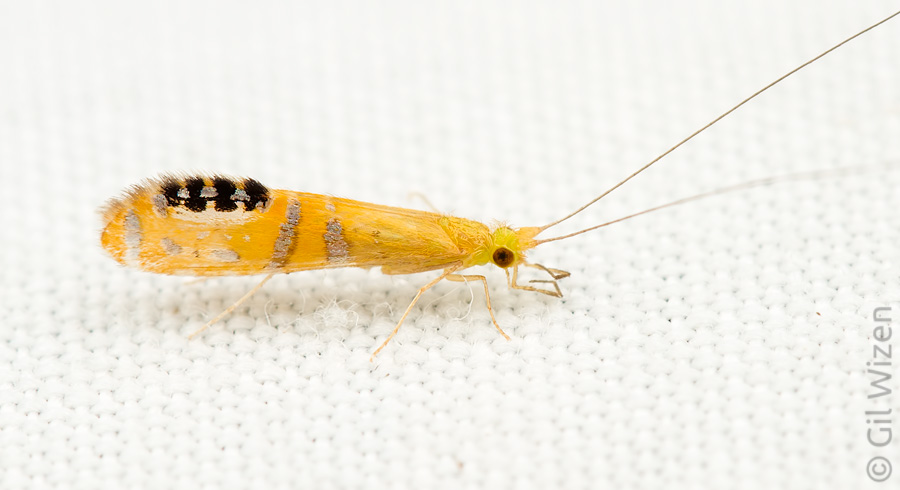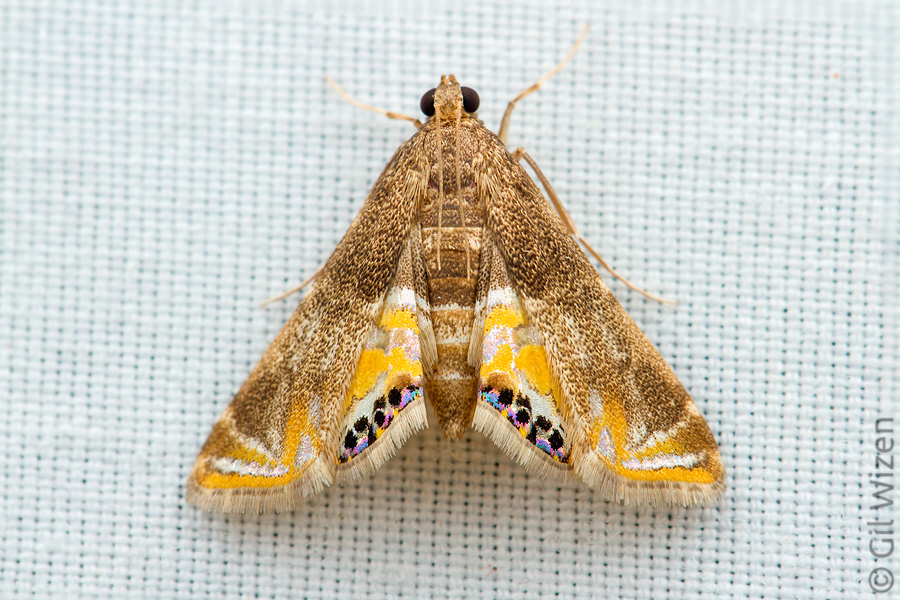Petrophila: Salticid-mimic moths
A few months ago, I returned to Belize to conduct a small arachnid survey. While I was there, I took part in designing insect light traps for Caves Branch Jungle Lodge. The concept of a light trap is simple – flying nocturnal insects use the moonlight to navigate at night, and when there is a brighter light source present (like a light bulb) they are attracted to it. We wanted to have a few traps set up before the beginning of BugShot, and we ran a few trials in several locations using different lighting settings to see what works best and which insects show up at the traps. Very soon we realized that the traps attracted an impressive diversity of insects, but also their predators – spiders, frogs and bats quickly learned the locations of the traps and came regularly to feed. In several occasions fire ants showed up to raid the unsuspecting insects.
One of the insects that we saw in great numbers every night was a small, plain-looking moth from the family Crambidae. I would probably not pay attention to it if it were not for four black dots arranged in a row on the margin of each of its hindwings. Many moths rest with their hindwings concealed by the forewings, however these moths, belonging to genus Petrophila, had a unique body posture at rest, exposing only the dotted part of their hindwings. This pattern looked very familiar to me, but I could not pinpoint from where exactly. Then a few nights later one of these moths decided to rest pointing sideways with its head rather than upwards like most moths. And it finally hit me: this moth has an image of a jumping spider on its wings looking straight at you. The mimicry is so convincing that the moth wings even have hair-like scales where supposedly the spider’s head is.
I should be careful here. Pareidolia is a known phenomenon in which one searches for known patterns just about anywhere. It is what makes people see the face of Jesus Christ on a burnt piece of toast, it is what makes you see a face on a rocky terrain on Mars, and it what makes you see a number when looking at the wings of Diaethria species.
What I mean to say is that the color pattern on the wings of Petrophila species reminds me of a salticid spider, and perhaps it works the same for other animals as well. There is also a behavioral display that makes the mimicry even more deceiving: the moth moves its wings to mimic the movements of a jumping spider. In search for a second opinion, I turned to someone who breathes and sleeps jumping spiders. Thomas Shahan, who fortunately was around for BugShot, confirmed my suspicion and even came up with an ID for a possible model spider: a female Thiodina sp. And so we went on to find a jumping spider that looked like the one shown on the moths’ wings. In any case, to my untrained eyes it seems that this pattern is common in several moth genera, and in other insects as well. Some will debate whether this apparent image actually evolved to depict what we want it to be, but I can only imagine the reaction of a jumping spider to this image and behavior by the moth. Jumping spiders are known to have good vision; a jumping spider will stall to examine an opponent to avoid conflict. This may give the moth a few seconds to escape. A good analysis of similar mimicry in other species is discussed here.

A different species of Petrophila, recorded from the same light trap. This one is smaller and seems to have a slightly different spider image.

The same Petrophila species as above, here with a possible salticid model – female Thiodina sp. from the same location in Belize. What I find amazing is that the wings even show some of the iridescence seen in the spider’s eyes.
Petrophila moths are unique among Lepidoptera for having aquatic caterpillars. They occupy running freshwater habitats, rivers and streams, where they feed on algae by scraping the surface of submerged rocks and stones. The genus has a wide distribution across the Americas and many species occur in temperate zones in addition to tropical regions.

You know the moths are successful in their mimicry when you find others deploying the same strategy: Nectopsyche is a genus of caddisflies (order Trichoptera) that shows a similar pattern – moth-like adults have four tiny black spots arranged in a row at the margin of their forewings, along with pale stripes.
Not only moths, but also many other insects orders were represented in our trap catch. I hope that Caves Branch continues to make good use of these sturdy light traps to record the insects surrounding the lodge. There is great potential for scientific work to be done here.





budak
There’s similar mimicry in moths and derbids in Asia too. This 1 cm moth (https://www.flickr.com/photos/budak/15222258525) keeps its wings upright and moves in an abrupt, jerky way like salticids, while this derbid nails it fully: https://www.flickr.com/photos/77246694@N00/9455339347
wizentrop
I have seen metalmark moths before, but that derbid is amazing! Thank you for sharing.
Michael Cook
I found your article while looking for info on the Petrophila moth / Salticid spider link I found in my own back yard – my shots aren’t as amazing as yours, but you can really see the resemblance!
http://www.wormspit.com/blog/2016/01/10/mimicry-and-seeing-life-in-macro/
Joe Lapp
This Petrophila at first fooled me into thinking it was a jumping spider — while I was out looking for spiders to show children:
http://bugguide.net/node/view/433093
It actually made a strange hopping motion when I approached.
A local naturalist friend field this jumping behavior, but apparently that link is broken now.